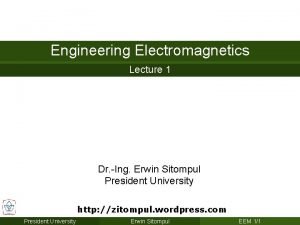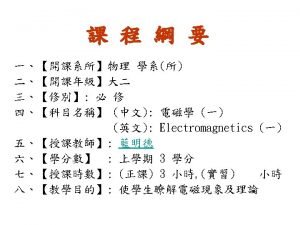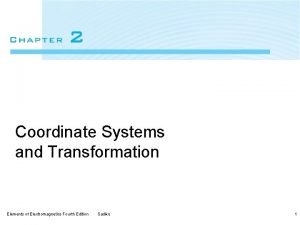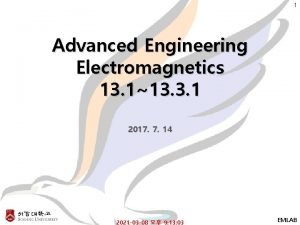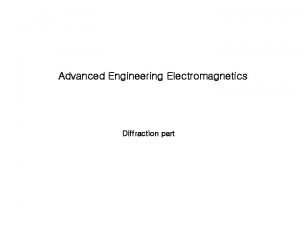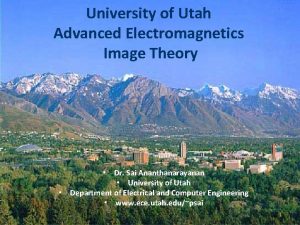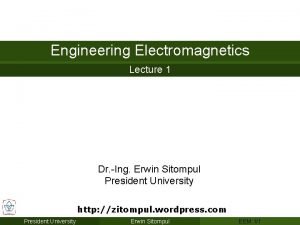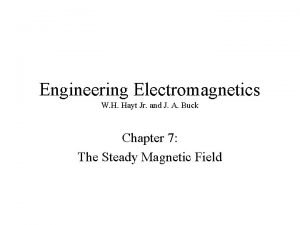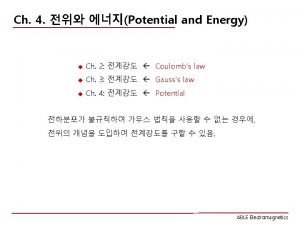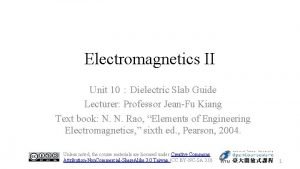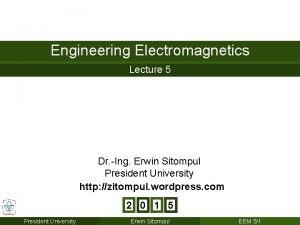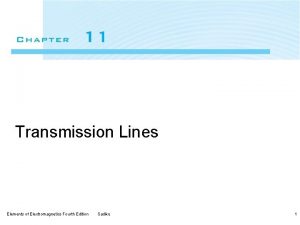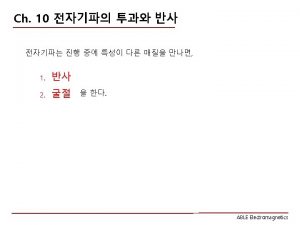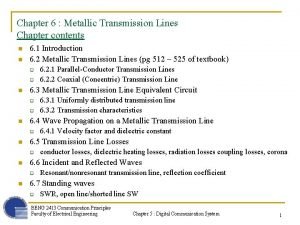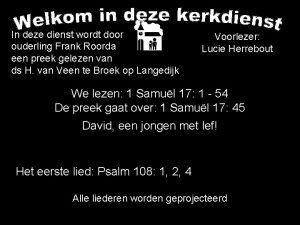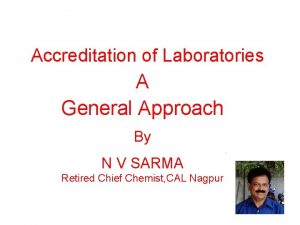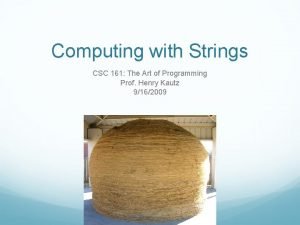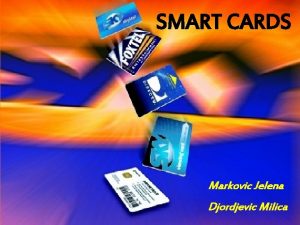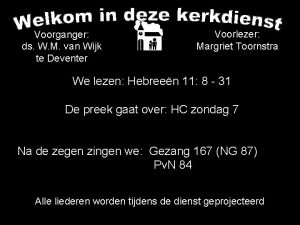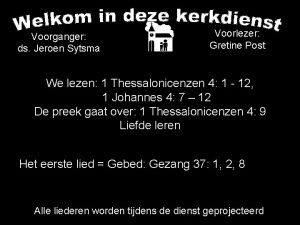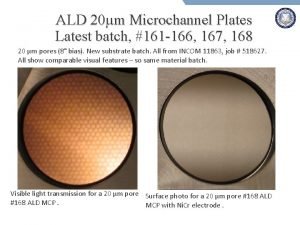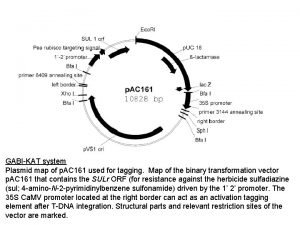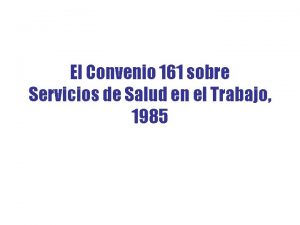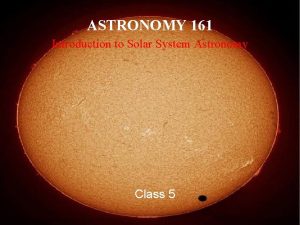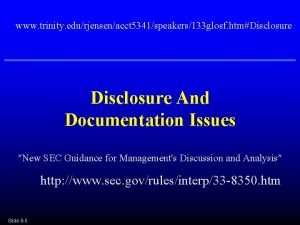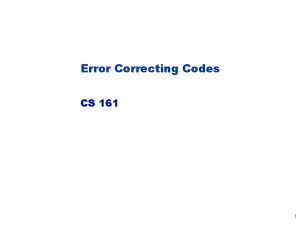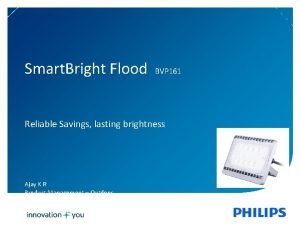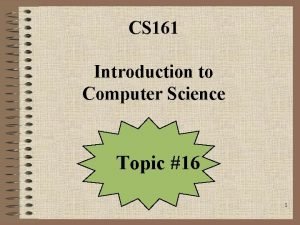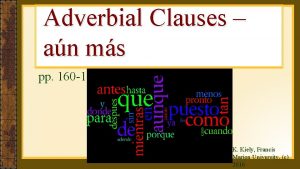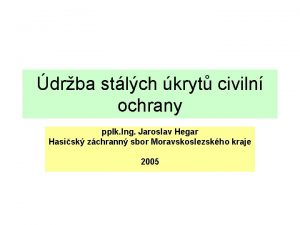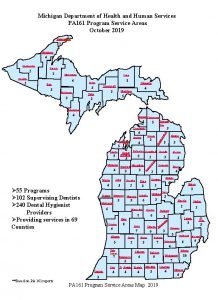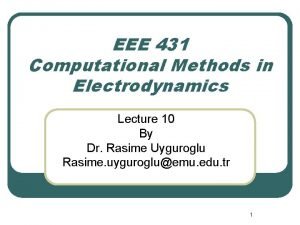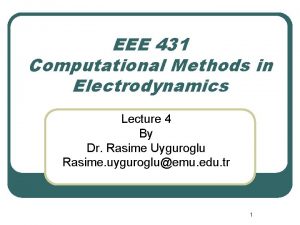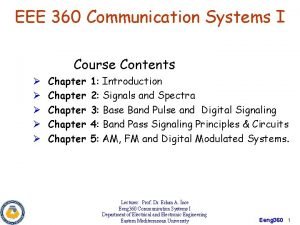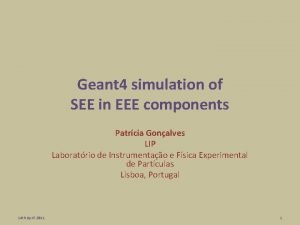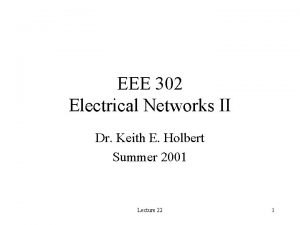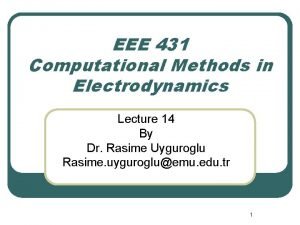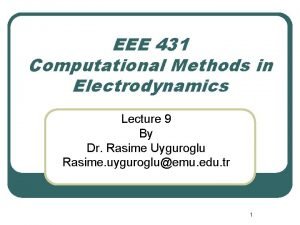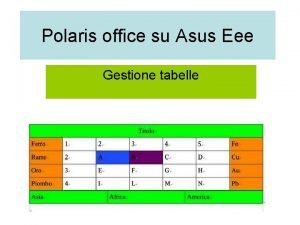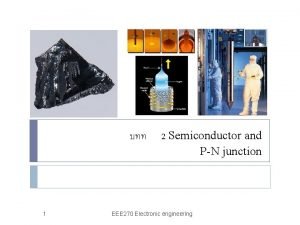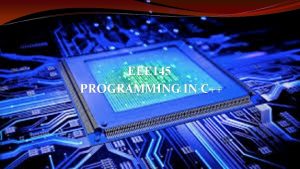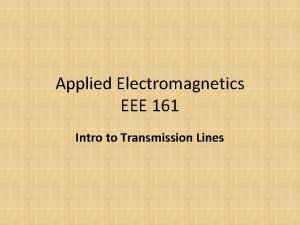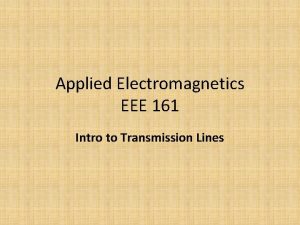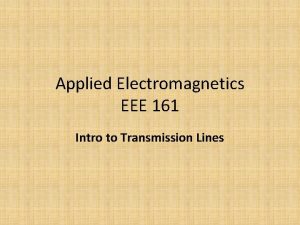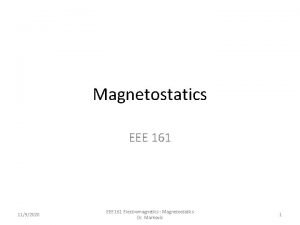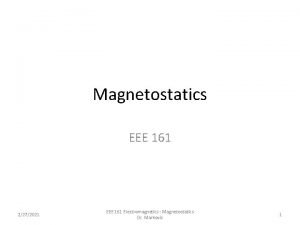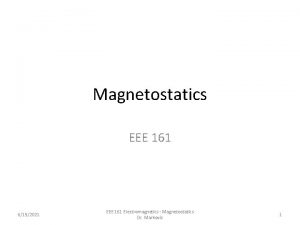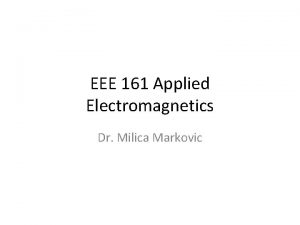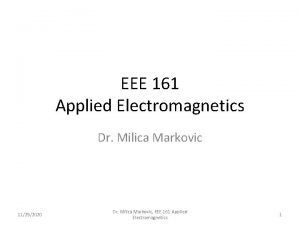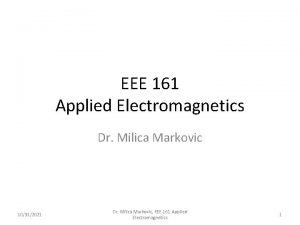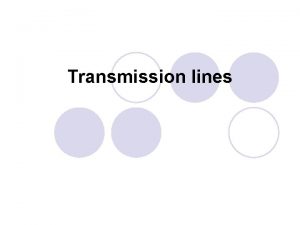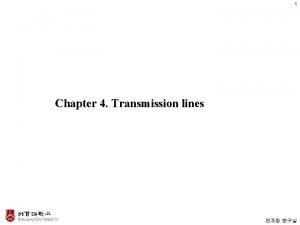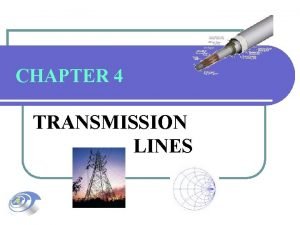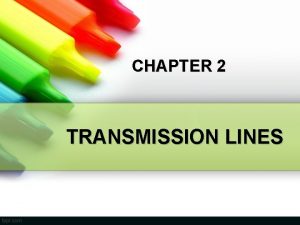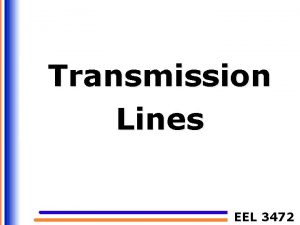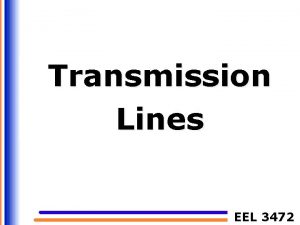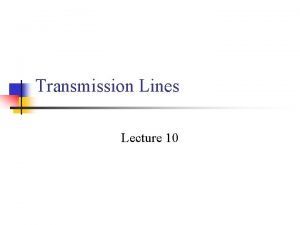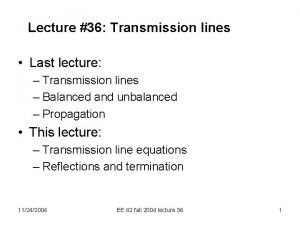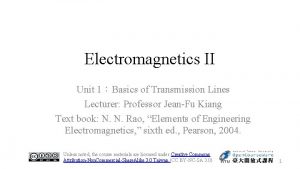Applied Electromagnetics EEE 161 Intro to Transmission Lines




















































- Slides: 52

Applied Electromagnetics EEE 161 Intro to Transmission Lines

LECTURE 1 – INTRO TO CLASS, GETTING TO KNOW EACH OTHER

Complex Numbers/Phasors at home reading • View the video about complex numbers: https: //www. youtube. com/watch? v=T 647 CGsu. OVU • View the phasor simulation: https: //en. wikipedia. org/wiki/File: Circle_cos_sin. gif • Read chapter 1, sections on Complex numbers and phasors. • Post at least 1 “muddiest point” (most unclear) in this reading on the Sac. CT discussion Complex Numbers and Phasors. These are graded as extra credit. • Due Week 2, day before first class.

Complex Numbers/Phasors at home reading • View the video about complex numbers: https: //www. youtube. com/watch? v=T 647 CGsu. OVU • View the phasor simulation: https: //en. wikipedia. org/wiki/File: Circle_cos_sin. gif • Read chapter 1, sections on Complex numbers and phasors. • Post at least 1 “muddiest point” (most unclear) in this reading on the Sac. CT discussion Complex Numbers and Phasors. These are graded as extra credit. • Due Week 2, day before first class.

Objective • In order to understand transmission lines we have to be able to describe sinusoidal signals first!

Motivation • Here is an equation of a wave • Here is an equation of a sinusoidal signal How are they the same and how are they different? Use vocabulary to name green and yellow highlights.

Sinusoidal Signal Describe this graph using at least 5 words!


Sinusoidal signals can be represented using complex numbers!

COMPLEX NUMBERS

Objective • To solve simple circuits we have to be able to apply basic arithmetic operations with complex numbers.

Complex numbers Cartesian Coordinate System Polar Coordinate System For example: Euler’s Identity

Quiz • Complex number Z=3+j 2 is given. – Sketch the number in Cartesian coordinate system – Find the magnitude and phase – Write a complete sentence to explain magnitude and phase on the diagram


Some concepts from complex #s Conjugate Division It is easier to divide/multiply complex numbers when they are in polar coordinates. Addition It is easier to add/subtract complex numbers when they are in _______ coordinates.

Which equation do we use to go from Polar to Rectangular coordinates?

Euler’s equation A A A

Quiz What is the real and imaginary part of the voltage whose amplitude is 2 and phase is 45 deg?

Quiz

Some more concepts Power and Square Root.

Quiz Calculate and sketch the magnitude and phase of the following three complex numbers:

Quiz Find the magnitude and phase of the following complex numbers:

Where did we see division of complex numbers? example in EE: Find magnitude and phase of the current in the circuit below How can we find magnitude and phase of this current in terms of variables R, L, V and ω?


Socrative Quiz • Find the voltage on the mystery circuit if the current through it was measured to be • The complex equation to find the voltage is



Homework 1 will be due soon!

Interesting Case Study in an Electrical Engineering Laboratory Let’s look at two simple circuits

Dr. M is measuring voltage in the laboratory using her handy-dandy Fluke. She measures voltages on the resistors and inductor to be as shown. She is shocked with the measurement on top and bottom circuit. Why? What do you think she expects, and what did she measure?


Objective • Students will be able to solve simple circuits using phasors

ac Phasor Analysis: General Procedure

ac Phasor Analysis: General Procedure

Example 1 -4 (p. 37): RL Circuit Cont.

Example 1 -4: RL Circuit cont.

Graded Quiz TL#1 A series R-L circuit is given as shown in Figure below. a) Derive equations for magnitude and phase of current and voltages on resistor and inductor in the phasor domain. Assume that the resistance of the resistor is R, inductance of the inductor is L, magnitude of the sourse voltage is Vm and phase of the source voltage is θ. Note that you don’t have numbers in this step, so to find the magnitude and phase for current I and voltages VR and VL you must first derive both numerator and denominator in polar form using variables R, omega, L, Vm, Vphase (do not use numbers). The solutions should look like equations in slide 24/27! b) In this step, assume that R=3Ω, L=0. 1 m. H, Calculate magnitude and phase of I, VL and VR by plugging in the numbers in the equations for VL, VR and I you found above. c) Sketch the phasor diagram. d) Finally, write the two voltages in the time domain.


Objectives • Students will be able to explain why is the relationship between sinusoidal signals and phasors valid in the previous table • If a sinusoidal signal is given in time domain, they will be able to recognize and derive the phasor expression • If a phasor of a signal is given, they will be able to recognize and derive the time-domain expression

Transformation • What is the transformation that we are using to transfer signals from time to frequency domain?

Transformation • What is the transformation that we are using to transfer signals from time to frequency domain? That’s great, but why? ?

Objective • Students will be able to explain how and why was the phasor transformation introduced

Superposition • If we have two generators in a linear circuit: – Remove one, find currents and voltages – Remove the other, find currents and voltages • The total voltage or current is equal to the sum of responses from the two cases above.

Backward Superposition • We have an existing cos(ωt) generator in the circuit • We add the second generator j*sin(ωt) • We find the currents and voltages in the circuit for the combined generator ejωt • Keep only the real part of the response

Guided Example solution similar to TL#2 What is the current in the series RL circuit below in Frequency Domain? * To find the current, we have to derive the phasor relation for KVL! *You can’t say right away V=RI+jωLI, because you don’t know if it is true. Start from time-domain KVL equation. What would that be?

How do we find out Phasor relation for KVL? • We don’t know the answer yet, so don’t start with KVL in FD. This is what we want to prove. • Write KVL in time domain. • Write the transformation for i(t), v(t) from time to frequency domain • Plug in i(t) and v(t) in TD KVL • Can you cancel some common terms?


Phasor Relation for Inductors Time domain Phasor Domain Time Domain

Graded Quiz #TL 2 • Derive the phasor relation for a capacitor • Derive the phasor relation for KCL in the circuit below 1. Write kcl in time domain 2. Relate currents to R and C in time domain 3. Write phasor def of I, V 4. Plug 3 in to TD eq.

Socrative Quiz To use voltage divider eq the same current has to flow through both impedances.

How are these two the same and how are they different? 1. You can use voltage divider in both 2. What is the difference between Xc=120 Ohms and R=120 Ohms 3. What is the difference between Xc(reactance) and Zc (impedance)? To use voltage divider eq the same current has to flow through both impedances.

How are these two the same and how are they different? 1. You can use voltage divider in both 2. What is the difference between Xc=120 Ohms and R=120 Ohms 3. What is the difference between Xc(reactance) and Zc (impedance)? To use voltage divider eq the same current has to flow through both impedances.
 Engineering electromagnetics
Engineering electromagnetics David cheng electromagnetics
David cheng electromagnetics Electromagnetics
Electromagnetics Advanced engineering electromagnetics
Advanced engineering electromagnetics Engineering electromagnetics
Engineering electromagnetics Image theory in electromagnetics
Image theory in electromagnetics Erwin sitompul
Erwin sitompul Ampere law statement
Ampere law statement Able electromagnetics
Able electromagnetics Able electromagnetics
Able electromagnetics Electromagnetics
Electromagnetics Engineering electromagnetics
Engineering electromagnetics Sadiku
Sadiku 스넬의 법칙
스넬의 법칙 Metallic transmission lines
Metallic transmission lines Gezang 161
Gezang 161 Gezang 161
Gezang 161 Astronomy 161
Astronomy 161 Psalm 161
Psalm 161 Nabl assessor course
Nabl assessor course Csc 161 rochester
Csc 161 rochester Jelena đorđevic 161
Jelena đorđevic 161 Gezang 161
Gezang 161 Jeroen sytsma
Jeroen sytsma Mcp 161
Mcp 161 Gabikat
Gabikat Convenio 161 oit resumen
Convenio 161 oit resumen 180-161
180-161 Dbx debugger
Dbx debugger Inls 161
Inls 161 Mini vidas scanner problem 161
Mini vidas scanner problem 161 Solar system astronomy class
Solar system astronomy class Fas161
Fas161 Error 161
Error 161 Cs161 ucr
Cs161 ucr Bvp 161
Bvp 161 Computer science 161
Computer science 161 Snmp ports
Snmp ports 160 161
160 161 Drba-161
Drba-161 Pa 161 program
Pa 161 program Computer security 161 cryptocurrency lecture
Computer security 161 cryptocurrency lecture Eee 431
Eee 431 Eee 431
Eee 431 Analog communication
Analog communication Eee components
Eee components Pdfcute
Pdfcute Quality factor of rlc circuit
Quality factor of rlc circuit Eee 431
Eee 431 Eee 431
Eee 431 Eee office
Eee office Eee
Eee Eee 145
Eee 145
